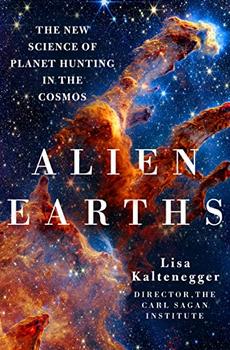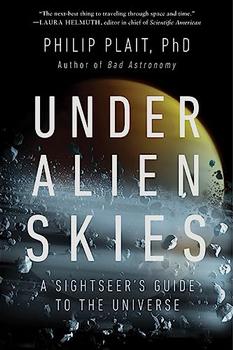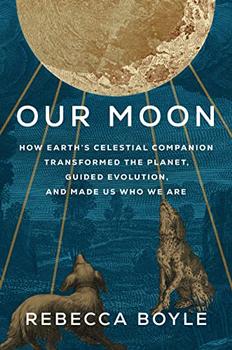Summary | Excerpt | Reviews | Beyond the book | Read-Alikes | Genres & Themes | Author Bio

The New Science of Planet Hunting in the Cosmos
by Lisa KalteneggerRiveting and timely, a look at the research that is transforming our understanding of the cosmos in the quest to discover whether we are alone.
For thousands of years, humans have wondered whether we're alone in the cosmos. Now, for the first time, we have the technology to investigate. But once you look for life elsewhere, you realize it is not so simple. How do you find it over cosmic distances? What actually is life?
As founding director of Cornell University's Carl Sagan Institute, astrophysicist Lisa Kaltenegger has built a team of tenacious scientists from many disciplines to create a specialized toolkit to find life on faraway worlds. In Alien Earths, she demonstrates how we can use our homeworld as a Rosetta Stone, creatively analyzing Earth's history and its astonishing biosphere to inform this search. With infectious enthusiasm, she takes us on an eye-opening journey to the most unusual exoplanets that have shaken our worldview - planets covered in oceans of lava, lonely wanderers lost in space, and others with more than one sun in their sky! And the best contenders for Alien Earths. We also see the imagined worlds of science fiction and how close they come to reality.
With the James Webb Space Telescope and Dr. Kaltenegger's pioneering work, she shows that we live in an incredible new epoch of exploration. As our witty and knowledgeable tour guide, Dr. Kaltenegger shows how we discover not merely new continents, like the explorers of old, but whole new worlds circling other stars and how we could spot life there. Worlds from where aliens may even be gazing back at us. What if we're not alone?
Chapter 1
At the Brink of Finding Life in the Cosmos
These worlds in space are as countless as all the grains of sand on all the beaches of the Earth. Each of those worlds is as real as ours and every one of them is a succession of incidents, events, occurrences which influence its future. Countless worlds, numberless moments, an immensity of space and time.
—Carl Sagan, Cosmos
The First Images from a New Spacecraft
The foam on my Portuguese espresso tastes a little bitter, but I hardly notice. For the past hour I've been staring at the images on my computer screen, a live feed from NASA's recently launched James Webb Space Telescope (JWST). The screen is dark now, and my own thoughts are wandering into that darkness, into what mysteries of the cosmos it will reveal.
Watching the flawless launch of the JWST on a late-December day in 2021, scientists from every continent focused intently on each step of the launch. From liftoff to observations, JWST had 344 single points of potential ...
The writing is woven with many scientific terms but is delivered in a highly digestible format. Marvelous and revelatory, Alien Earths will get you excited for our burgeoning, promising efforts to reach cosmic life on Earth-similar exoplanets. So much has already been learned in just a few decades, and we're only getting started. Thanks to Dr. Lisa Kaltenegger and her fellow scientists, we are closer than ever to meeting life on another planet. It's only a matter of patience, perseverance, and time...continued
Full Review
 (727 words)
(727 words)
(Reviewed by Christine Runyon).
 Alastair Reynolds, science fiction writer and former ESA scientist
An engaging and personal book that couldn't be more up to date. Read Alien Earths, and feel your cosmic perspective shift just a little on its axis.
Alastair Reynolds, science fiction writer and former ESA scientist
An engaging and personal book that couldn't be more up to date. Read Alien Earths, and feel your cosmic perspective shift just a little on its axis. Bill Nye, CEO, The Planetary Society (and former student of Carl Sagan)
If you've ever wondered if we're alone in the cosmos― and Dr. Kaltenegger is certain you have, start with Alien Earths. With her combined degrees in astronomy and engineering, she presents a primer on the geology, physics, chemistry, biology, and ultimately mathematics of places just like Earth― which she sets about seeking every (Earth) day. She'll show you; the answer is in the sky, our window on the cosmos. Read on!
Bill Nye, CEO, The Planetary Society (and former student of Carl Sagan)
If you've ever wondered if we're alone in the cosmos― and Dr. Kaltenegger is certain you have, start with Alien Earths. With her combined degrees in astronomy and engineering, she presents a primer on the geology, physics, chemistry, biology, and ultimately mathematics of places just like Earth― which she sets about seeking every (Earth) day. She'll show you; the answer is in the sky, our window on the cosmos. Read on! Michel Mayor, Winner of the Nobel Prize in Physics, Professor Emeritus, Department of Astronomy, University of Geneva
Do you want to prepare yourself for the next 'Copernican revolution'? Then read Lisa Kaltenegger's book! Fascinating.
Michel Mayor, Winner of the Nobel Prize in Physics, Professor Emeritus, Department of Astronomy, University of Geneva
Do you want to prepare yourself for the next 'Copernican revolution'? Then read Lisa Kaltenegger's book! Fascinating. Neil deGrasse Tyson, Astrophysicist, American Museum of Natural History
In Alien Earths, Lisa Kaltenegger, a skillful educator, offers first-hand access to her expertise on the search for planets in the universe, and the life they may contain. Along the way, Lisa's breezy narrative style invites you to experience with her the challenges and joys of being a scientist on the frontier of discovery.
Neil deGrasse Tyson, Astrophysicist, American Museum of Natural History
In Alien Earths, Lisa Kaltenegger, a skillful educator, offers first-hand access to her expertise on the search for planets in the universe, and the life they may contain. Along the way, Lisa's breezy narrative style invites you to experience with her the challenges and joys of being a scientist on the frontier of discovery. Steven Strogatz, Professor of Mathematics, Cornell University, and author of Infinite Powers
Professor Lisa Kaltenegger takes us along on the quest to solve one of the greatest mysteries of existence: Are we alone in the universe? In Alien Earths, Kaltenegger―one of the pioneers leading the way―reveals what we've already discovered, and even more breathtakingly, what we might find.
Steven Strogatz, Professor of Mathematics, Cornell University, and author of Infinite Powers
Professor Lisa Kaltenegger takes us along on the quest to solve one of the greatest mysteries of existence: Are we alone in the universe? In Alien Earths, Kaltenegger―one of the pioneers leading the way―reveals what we've already discovered, and even more breathtakingly, what we might find.From the 17th century on, Johannes Kepler, Mary Shelley, Edgar Allan Poe, Jules Verne, HG Wells, and Edgar Rice Burroughs were just a few artists who contributed to a burgeoning awakening of the collective imagination, melding scientific and cosmic theories with myth and character, shaping something entirely new — science fiction.
How science fiction evolved from simple stories into a huge pop culture phenomenon could be an article unto itself. But it's worth noting that in 1966, science fiction was transformed forever when Star Trek premiered on NBC. In the show, the Starfleet organization was conceived with the goal of exploring and learning from our neighboring galaxies in the universe. Sound familiar? As it turns out, NASA was ...

If you liked Alien Earths, try these:

by Philip Plait
Published 2024
A rip-roaring tour of the cosmos with the Bad Astronomer, bringing you up close and personal with the universe like never before.

by Rebecca Boyle
Published 2024
Our Moon invites us to reexamine our relationship with our closest cosmic companion.




The fact of knowing how to read is nothing, the whole point is knowing what to read.
Click Here to find out who said this, as well as discovering other famous literary quotes!